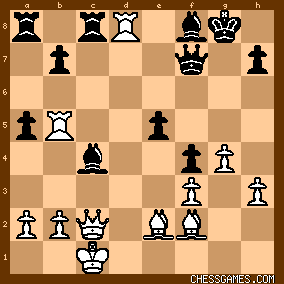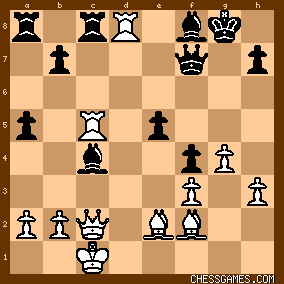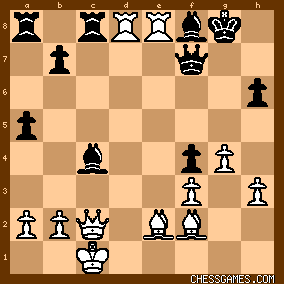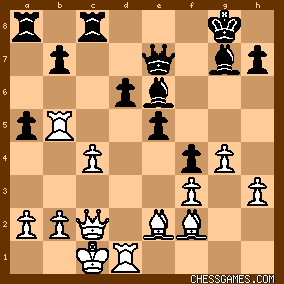| Jan-20-17 | | YouRang: Thursday 26.?

click for larger view
I thought this was much easier than yesterday's puzzle. White would love to play Bxc4 which pins and wins black's queen. However, this idea is stopped by the Rc8. So, we can try and deflect Rc8 with <26.Rd8+!>, and since 26...Rxd8 loses to 27.Bxc4, black must block check with <26...Bf8>

click for larger view
But this Bf8 is now pinned, which permits a neat interference tactic: <27.Rc5!>

click for larger view
What are black's options:
- 27...Rxc5? 28.Bxc5, unable to stop both Rxa8 and Bxc4 - 27...Bxc2 (eliminates the Bxc4 threat, but...) 28.Rcxd8 Rxc8 29.Rxc8, unable to stop both Qxe2 and Bc5 (winning Bf8). - 27...Rxd8 loses to 28.Bxc4
I see this isn't how the game went, but I think this is just as good. |
|
| Jan-20-17 | | TheBish: Akobian vs R Barcenilla, 2015 White to play (26.?) "Difficult"
This one looks very familiar. I believe it was featured as one of the tactics positions in Andy Soltis' "Chess to Enjoy" column in Chess Life. 26. Rd8+! Bf8
Forced, since if 26...Rxd8 27. Bxc4 wins the queen for a rook. 27. Rxe5!
Here I believe Akobian played 27. Rxf8+!? Kxf8 28. Rxe5 (threatening 28. Rf5), but 27. Rxe5 is an improvement which leads to a quicker win, as Black can't meet all the threats, principally 28. Rg5+ Kh8 29. Qc3+, mating. Somebody may have already had their engine spit out the analysis on this line, will be interesting to see. But time doesn't permit me to analyze this line too deeply... it's sufficient I guess to know that it's a crushing position! |
|
| Jan-20-17 | | AlicesKnight: Saw 26.Rd8+ as the basis but could not find a conclusive follow-up after ....Bf8, looking for something more immediate. |
|
Jan-20-17
 | | al wazir: I got 26. Rd8+ Bf8 right away, but then I wanted to follow that with 27. Rc5. After 27...Rxc5 (27...Bxe2 28. Rcxc8 Rxc8 29. Qxc8; 27...Rxd8 28. Bxc4, skewering the ♕) 28. Bxc5 Rxd8 (28...Bxe2 29. Rxa8 Qc4 30. Rxf7+) 29. Bxc4 Rd5 30. Qe4, white is a piece up. Not a mate, but an easy win. |
|
Jan-20-17
 | | al wazir: I see <YouRang> already posted the same sequence. I take that as confirmation of my analysis. |
|
| Jan-20-17 | | gofer: Today is simple! <Its just a step to the right!> <26 Rd8+ ...>
Black has no good replies and can probably resign. 26 ... Rxd8
27 Bxc4 
26 ... Qf8
27 Rxf8+ 
<26 ... Bf8>
<27 Rc5! ...>
27 ... Rxd8
28 Bxc4 
27 ... Rxc5
28 Bxc5 Bxe2
29 Rxa8 
27 ... Bxe2
28 Rcxc8 Rxc8
29 Rxc8 (avoiding 29 ... Qc4) 
~~~
Yep, so I am happy, but I see <TheBish>: has found <27 Rxe5>!!! Nice. |
|
| Jan-20-17 | | WorstPlayerEver: 26. Rd8 Bf8 27. Re5 h6 28. Ree8 |
|
| Jan-20-17 | | WorstPlayerEver: 
click for larger view |
|
| Jan-20-17 | | morfishine: Straightforward check & deflect theme well-played by Akobian ***** |
|
Jan-20-17
 | | rodchuck: I wanted to play 27 Rc5, but <you rang> and <al wazir> got there before me! Clear analysis from both - thanks |
|
| Jan-20-17 | | agb2002: The material is identical.
Black threatens Bxb5.
The rook on c8 protects Black's lsb. This suggests 26.Rd8+ Bf8 (26... Rxd8 27.Bxc4 Rac8 28.Bxf7+ Kxf7 29.Rc5 + - [Q vs R]) 27.Rxf8+ Kxf8 (27... Qxf8 28.Bxc4+ + - [2B vs R]; 27... Rxf8 28.Bxc4 wins the queen) 28.Bc5+ Rxc5 (else 29.Bxc4 as in the first subline) 29.Rxc5: A) 29... Bxe2 30.Rc7
A.1) 30... Qxa2 31.Qf5+ and mate soon. For example, 31... Kg8 32.Qg5+ Kf8 33.Qg7+ Ke8 34.Qe7#. A.2) 30... Qg6 31.Qc5+ Kg8 (31... Ke8 32.Qe7#) 32.Qd5+ A.2.a) 32... Kh8 33.Qxe5+ Kg8 34.Qxe2 and White is a pawn ahead with the threats Rxb7 and Qc4+ followed by Qxf4. A.2.b) 32... Kf8 33.Qxe5 Kg8 (33... Re8 34.Qh8+ and mate in two) 34.Qxe2 as above. A.3) 30... Qe6 31.Qxh7
A.3.a) 31... Qf6 32.g5 Qe6 (32... Qxg5 33.Qh8+ Qg8 34.Qf6+ Ke8 35.Qe7#) 33.Qh8+ and mate in two. A.3.b) 31... Bc4 32.Qh8+ (32.Rg7 Qc6 33.Qh8+ Bg8+ 34.Kb1 Qe6 - +) 32... Qg8 33.Qf6+ Bf7 (33... Ke8 34.Qe7#) 34.Qd6+ Kg7 35.g5 (threatens 36.Qh6#) A.3.b.i) 35... Qf8 36.Qf6+ Kg8 (36... Kh7 37.Rxf7+ wins) 37.g6 looks winning. For example, 37... Bxa2 38.Qh4 Qg7 39.Rxg7+, etc. A.3.b.ii) 35... Qh8 36.Qf6+ and mate in two.
A.3.b.iii) 35... Kh8 36.Qf6+ Qg7 37.Qxf7 Qxf7 (37... Rg8 38.Qxg7+ Rxg7 39.Rxg7 Kxg7 40.Kd2 + -) 38.Rxf7 with an extra pawn and the double threat Rxb7 and Re7 looks very good for White. A.3.c) 31... Rc8 32.Qh8+ and mate in three.
A.4) 30... Qf6 31.Qxe2 and material is equal but with the better position due to the weaknesses b7, e4, e5, h7, the seventh rank and the diagonal b1-h7. A.5) 30... Bd3 31.Rxf7+ wins.
B) 29... Bxa2 30.Rc7
B.1) 30... Qe6 31.Qxh7 looks similar to previous lines. For example, 31... Qf6 32.g5 Qe6 33.Qh8+ Qg8 34.Qf6+ Bf7 35.Bc4 wins. B.2) 30... Qf6 31.b3 seems to trap the bishop. For example, 31... Qd6 32.Qf5+ Kg8 (32... Ke8 33.Bb5+ Kd8 34.Rd7+ wins) 33.Qg5+ Qg6 34.Bc4+ Kh8 35.Qxe5+ and mate next. B.3) 30... Qg6 31.Bd3 looks very good for White. For example, 31... Qe6 32.Bf5 Qd5 (32... Qb3 33.Qc5+ and mate in two) 33.Bxh7 Qe6 34.Qc5+ Ke8 35.Bg6+ Kd8 (35... Qxg6 36.Qe7#) 36.Bf5 Qf6 37.g5 Qxg5 (37... Qxf5 38.Qe7#) 38.Qd6+ Ke8 39.Bg6+ wins. C) 29... b5 30.Rxc4 wins a piece (30... bxc4 31.Bxc4, etc.). |
|
| Jan-20-17 | | Akabara: I went with
26. Rd8 Bf8
like already pointed out. However my next move is the slow-paced 27. Rxe5
dominating the black queen's light diagonal. Black is nearly in a state of zugzwang at this point. If you go for 27... Kg7
28. Rg5+
there is either a mating sequence or you're forced to give up your Q for a R (at least).
If you play a passive move like
27... h6
28. Rf5
will easily collect the bishop. Black is neatly tied up and is forced to give up big material here. I dislike the game's continuation, as it allows some sort of counter play, more calculations is involved in my opinion. |
|
| Jan-20-17 | | WorstPlayerEver: Nah...
26. Rd8 Bf8 27. Re5 Kg7 28. Rh5 Qh5
-29. gh5 Rd8 30. Qc3 Kf7 mate in 10.
-29. gh5 Be6 30. Rc8 Rc8 31. Bd4 (Kg8 32. Qc8) Kh6 32. Bc3 Bd6 33. Qe4 Ba2 mate in 20 😊 |
|
| Jan-20-17 | | cocker: 32 ... Ra7 was losing move; 32 ... Rd8 would have set White problems. |
|
| Jan-20-17 | | mel gibson: The first few moves are obvious -
this is not a difficult puzzle. |
|
| Jan-20-17 | | Clodhopper: The weird thing is that I saw 27. Rxe5, which is superior to the move played in the game. But then after 27 ... Be6, 28. Rg5+ , Qg6, 29. Rg6+, h7xg6 I missed 30 Rxf8+ which wins instantly, and instead went for 30. Rxc8. This leads to a 2B vs 2B ending with white a pawn up. But 30. Rxf8+, Kxf8, 31. Bc5+ is a crusher that I didn't see till the computer pointed it out.. |
|
| Jan-20-17 | | YouRang: <Clodhopper: The weird thing is that I saw 27. Rxe5, which is superior to the move played in the game. But then after 27 ... Be6, 28. Rg5+ , Qg6, 29. Rg6+, h7xg6 I missed 30 Rxf8+ which wins instantly, and instead went for 30. Rxc8. This leads to a 2B vs 2B ending with white a pawn up. But 30. Rxf8+, Kxf8, 31. Bc5+ is a crusher that I didn't see till the computer pointed it out..> Yes, I see that the computer's first choice (by a modest margin) is 27.Rxe5 over 27.Rc5, with 27.Rxf8 a distant third. But 27.Bxe5 didn't "jump out" to me at all, and it strikes me as more complicated. However, 27.Bc5 did jump out because it contributed directly to the original objective of threatening to pin black's queen with Bxc4. - 26.Rd8+ threatened to do it by deflecting the defender Rc8. - 27.Rc5 threatened to do it by blocking the defense of Rc8. It's not too hard to see that black can't cope with both threats. |
|
| Jan-20-17 | | drollere: i looked at
26. Rd8+ Bf8
27. Rxf8+ Kxf8
and didn't see any particular advantage to white, and no longer any way to skewer the Q with Bxc4. so i kept looking. i didn't see Bc5+ which either wins back the exchange or allows Bxc4 outright. it seems a pretty intricate way to trade down to equality in material, but the black K is finally exposed to too many mating alternatives, i think mostly because of the imprudent Qxa2 and the mate that follows 35. ... Rf7. |
|
| Jan-20-17 | | RandomVisitor: After 24.Rd1

click for larger viewKomodo-10.1-64bit:
<0.00/32 24...Rc6> 25.c5 d5 26.Bd3 h6 27.Kb1 Rac8 28.Bf5 d4 29.Qe4 a4 30.Bxe6+ Qxe6 31.Rc1 R8c7 32.Ra5 Qc8 33.Rc2 Rxc5 34.Raxc5 Rxc5 35.Rxc5 Qxc5 36.Qxb7 Qc4 37.Qe4 Qf1+ 38.Be1 Qxh3 39.Qd5+ Kh7 40.Qe4+ Kh8 41.Qa8+ Kh7 42.Qe4+ |
|
| Jan-20-17 | | RandomVisitor: After 26.Rd8+ Bf8

click for larger viewKomodo-10.1-64bit:
<+7.79/31 27.Rxe5> Be6 28.Rg5+ Qg6 29.Rxg6+ hxg6 30.Rxf8+ Kxf8 31.Bc5+ Kf7 32.Bc4 Rc6 33.Bxe6+ Rxe6 34.Qb3 b6 35.Qd5 Rae8 36.Bxb6 a4 37.Bd4 R8e7 38.Be5 Ra7 39.Bxf4 Raa6 40.Be5 Ke8 41.f4 Rec6+ 42.Kd2 Ke7 43.Ke3 Rab6 44.Qa5 Ra6 45.Qb4+ Kd7 46.Qb7+ Ke8 47.Kd2 Re6 48.Kd3 Rec6 49.Ke3 Re6 50.Qd5 +6.12/31 27.Rc5 Bb3 28.Rcxc8 Bxc2 29.Rxa8 Bg6 30.Rac8 Kg7 31.Bc4 Qe7 32.Rxf8 Qxf8 33.Rxf8 Kxf8 34.Kd2 Ke7 35.Bb6 h5 36.Bxa5 hxg4 37.hxg4 e4 38.Ke2 Kd6 39.Bb4+ Ke5 40.Bc3+ Kd6 41.Bd4 e3 42.b3 Bb1 43.a3 Bg6 44.a4 Be8 45.Ba7 Kc7 46.Bc5 Bg6 47.g5 Bh5 48.Bd5 Bg6 49.Bd4 +1.43/31 27.Rxf8+ Kxf8 28.Bc5+ Rxc5 29.Rxc5 Bxe2 30.Rxe5 Ra6 31.Qxe2 Rc6+ 32.Kb1 Qg6+ 33.Re4 Re6 34.Kc1 Rc6+ 35.Rc4 h5 36.Kd2 Rd6+ 37.Ke1 Qf6 38.Kf1 Rc6 39.Re4 Rc1+ 40.Kg2 Qd6 41.gxh5 Rc5 42.Re6 Rg5+ 43.Kh2 Qc5 44.Qe1 Rxh5 45.Rf6+ Kg7 46.Rxf4 Qd6 47.Qg3+ Kh6 48.h4 b5 49.Re4 Rd5 50.Re2 Qf6 51.Qg4 Re5 52.Rxe5 Qxe5+ 53.Kh3 Qf6 54.Qe4 Qxb2 |
|
| Jan-20-17 | | WorstPlayerEver: 26. Rd8 Bf8 27. Re5 Be6 28. Rg5 Qg6 29. Rg6 hg6 30. Rf8 Kf8 31. Bc5 Kf7 32. Bc4 Rc6 33. Be6 Re6 34. Qb3 b6 35. Qd5 Re8 36. Bb6 a4 37 Bc7 Re7 mate in 25 😉 |
|
| Jan-20-17 | | Cheapo by the Dozen: LOL at <gofer>'s Time Warp reference! I had the same solution process as a lot of folks: -- Bxc4 seems central to winning ideas.
-- The c-file pin is a problem.
-- The pinning rook can be diverted via Rd8+ or interposed against on c5.
-- The win involves being ready to do BOTH those things. But that actually led me to Bc5 as the interposition, not Rc5. The virtue of that approach is to increase the seriousness of the Rxf8+ threat. |
|
| Jan-20-17 | | Carlos0012358: <agb2002> You must have had lots of free time today. |
|
| Jan-20-17 | | latebishop: My inspiration was also 26.Rd8+ Bf8 27. Rc5 but looking further after 27...Rxd8 28.Bxc4 Bxc5 29.Bxf7+ Kxf7 30.Bxc5 R(a8)c8 White seems to have problems with his bishop pinned to his king |
|





